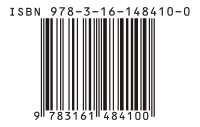
ISBN
Unique numeric book identifier since 1970 / From Wikipedia, the free encyclopedia
Dear Wikiwand AI, let's keep it short by simply answering these key questions:
Can you list the top facts and stats about International Standard Book Number?
Summarize this article for a 10 year old
The International Standard Book Number (ISBN) is a numeric commercial book identifier that is intended to be unique.[lower-alpha 1][lower-alpha 2] Publishers purchase or receive ISBNs from an affiliate of the International ISBN Agency.[2]
 A 13-digit ISBN, 978-3-16-148410-0, as represented by an EAN-13 bar code | |
| Acronym | ISBN |
|---|---|
| Organisation | International ISBN Agency |
| Introduced | 1970; 54 years ago (1970)[1] |
| No. of digits | 13 (formerly 10) |
| Check digit | Weighted sum |
| Example | 978-3-16-148410-0 |
| Website | isbn-international |
A different ISBN is assigned to each separate edition and variation of a publication, but not to a simple reprinting of an existing item. For example, an e-book, a paperback and a hardcover edition of the same book must each have a different ISBN, but an unchanged reprint of the hardcover edition keeps the same ISBN. The ISBN is ten digits long if assigned before 2007, and thirteen digits long if assigned on or after 1 January 2007.[lower-alpha 3] The method of assigning an ISBN is nation-specific and varies between countries, often depending on how large the publishing industry is within a country.
The first version of the ISBN identification format was devised in 1967, based upon the 9-digit Standard Book Numbering (SBN) created in 1966. The 10-digit ISBN format was developed by the International Organization for Standardization (ISO) and was published in 1970 as international standard ISO 2108 (any 9-digit SBN can be converted to a 10-digit ISBN by prefixing it with a zero).
Privately published books sometimes appear without an ISBN. The International ISBN Agency sometimes assigns ISBNs to such books on its own initiative.[4]
A separate identifier code of a similar kind, the International Standard Serial Number (ISSN), identifies periodical publications such as magazines and newspapers. The International Standard Music Number (ISMN) covers musical scores.